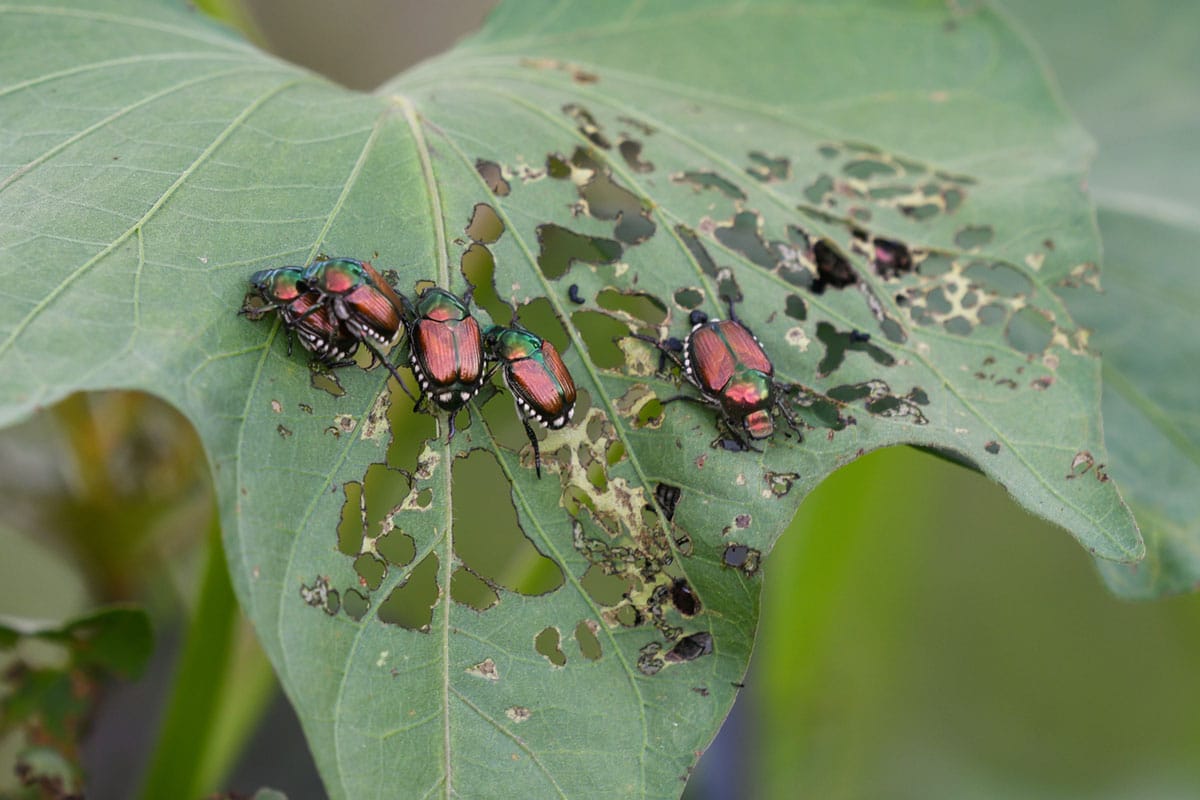More and more, we hear about the presence of Japanese beetles in Quebec, especially in the southern regions. We talk about their propagation of course, but what is most surprising is the damage they cause and especially, the quantity of plants that fall victim to it. It would indeed be easier to name the species that Japanese beetles do not devour than those that attract them: there are more than 400! Once you are invaded by this pest, it is quite difficult to get rid of it. Prevention is therefore your number one ally in the fight against the Japanese beetle.
In its larval stage, the Japanese beetle feeds on the roots of low-growing grasses, mainly turf. Yellow patches of grass will appear on your lawn and it will pull up like a carpet when you pull on it. If you dig a little, you will see the larvae very well: large, plump white worms. The adults, large beetles with a beautiful metallic green body, devour – and that’s an understatement – the stems, flowers, fruits and leaves of plants, leaving only their skeleton. They are very voracious and leave no chance to the plants that fall under their teeth.
Preventing and controlling grubs
The larvae of the Japanese beetle are part of the grub family that ravage lawns. Therefore, this is the stage at which they cause damage. Unlike the larvae of the common or European chafer, Japanese beetles will continue to cause damage in the adult stage. It’s hard to know what type of beetle your larvae came from, but the way to treat them is the same. There are over-the-counter products to treat white grubs, ask our garden centre specialists.
The thicker and healthier your lawn, the less likely it is to be invaded by grubs. In fact, in order to hatch, the eggs must touch the ground and migrate quickly. Don’t give them a chance: mow regularly to a height of 8 cm, fertilize the lawn properly in the spring, summer and fall, repair any damaged areas quickly and make your lawn thicker by topdressing and overseeding.
To give yourself even more of a chance, in July when the adults emerge, turn off the lights on your property. Light attracts these gregarious insects, so you may find yourself with a nice colony in your yard, ready to devour your best plants and lay eggs in your lawn to continue their reproductive cycle.
Struggling with Japanese beetles? What to do?
You can collect the insects by dropping them in soapy water to get rid of them so that the cycle stops. You can also spray insecticidal soap on your plants so that the beetles do not attack them. Remember, however, that you must do this daily.
Some plants, including geraniums, are toxic to beetles. They have to eat them for the treatment to work, so be prepared to sacrifice some plants to protect the others. Plant them in a corner away from other plants to attract the beetles to that spot. Alliums (garlic, onions) are also said to be a repellent: plant some in your garden!
Pheromone traps
You can find pheromone traps in garden centres that are specially designed to attract Japanese beetles. Be sure to place them away from your plants so that the beetles don’t feed on their way to their final destination. These traps are effective if emptied daily at the height of the season.
A natural pest
The beetle fly, a natural parasite that invests and then kills its host, is starting to spread here. If you see beetles with white spots on the head and thorax, don’t touch them. We want to encourage the multiplication of this species which could effectively control the Japanese beetle.
Come and meet our specialists in store who will be able to direct you towards effective control solutions for the Japanese beetle and many others.







